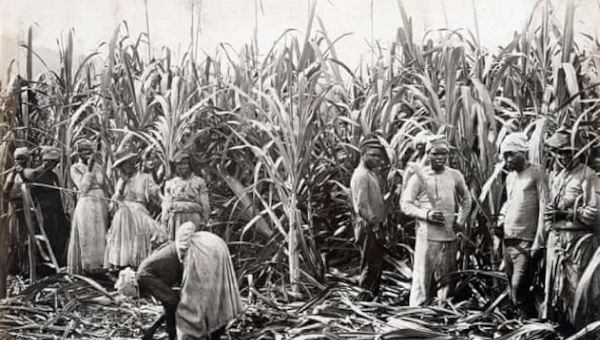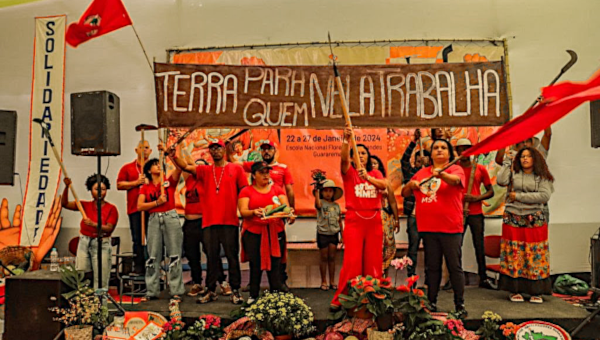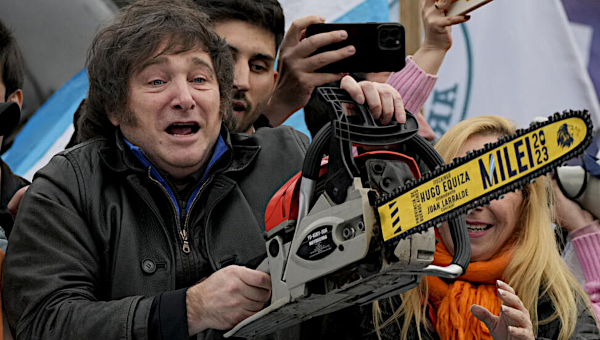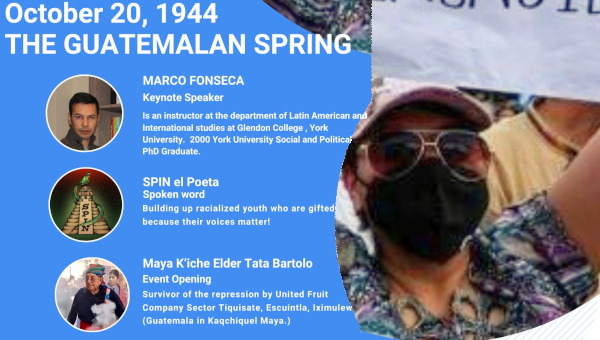Crisis, Populist Neoliberalism and the Limits to Democracy in Mexico
Forbes magazine recently placed two Mexicans, Carlos Slim and Joaquín Guzmán, high on their list of the most powerful people in the world. Carlos Slim is the world’s third-richest man and CEO of a telecommunications company and Joaquín Guzmán is the leader of the Sinaloa drug cartel. While the purpose and the methodology of this list is problematic, the inclusion of these two names in Forbes’ list tells us a lot about the long night of neoliberal rule in Mexico as well as the current administration of Felipe Calderón, who belongs to the centre-right Action National Party (PAN).
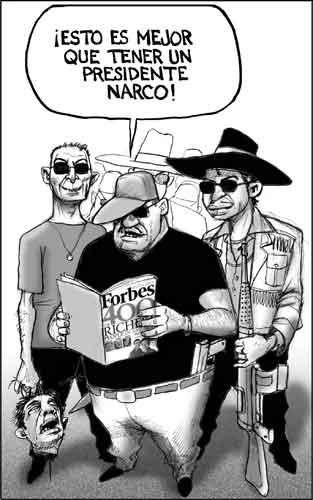
The neoliberal policies that squeeze wages and working conditions downward while promoting private investment help explain Mexico’s combination of incredible wealth on the one hand and sharply rising poverty on the other. Global banks such as Citigroup now consider their Mexican subsidiaries as their main source of profit. While accumulation and impoverishment continue hand in hand, the increasing violence, insecurity and impunity caused by the rising power of drug cartels and the indifference, if not collaboration, of local authorities, particularly in some Northern states, have put a double-burden on the Mexican population, who do not only see their economic security but also their physical safety continuously threatened.
This is the context where both the PAN and the PRI (Institutional Revolutionary Party) – the party that monopolized the three branches of government for almost 70 years – compete with a strategy of populist neoliberalism, each claiming that they can do a better job at fighting organized crime than the other. This has great popular appeal as the constantly escalating crime and insecurity affect all sectors of the population. At the same time, both parties are committed to the neoliberal model that has allowed Slim and other companies to obtain and sustain their wealth. The commonalities and differences in the PRI’s and PAN’s populist neoliberalism can be seen in the policies undertaken to fight organized crime and the 2010 Budget negotiations in the Mexican Congress in the context of the global crisis.
Mexico in the Global Crisis and
the Failures of Mexico’s Development Model
When the credit crisis unfolded in the United States in 2008, Mexico’s president claimed that the economic policies implemented by his predecessors, Ernesto Zedillo (1994-2000) and Vicente Fox (2000-2006), had allowed the government to accumulate international reserves in order to protect the Mexican economy from external shocks. He further argued that such reserves were going to be employed in protecting the Mexican peso to maintain investors’ confidence, investing in infrastructure to create jobs and providing incentives to foreign direct investment to stay in the country.
Despite these measures, Mexico is one of the Latin American countries that has been hardest hit by the global crisis. According to the Organization of Economic Cooperation and Development, Mexico’s GDP fell by 9.7 percent in 2009. The United Nations Economic Commission for Latin America and the Caribbean (ECLAC) indicated that Mexico was one of the few countries in Latin America where poverty actually increased between the years 2006 and 2008. According to ECLAC’s report, the percentage of people under conditions of poverty in Mexico rose from 31.7 to 34.8 percent.
The Mexican government has explained this outcome in terms of the severity of external shocks such as lower oil prices, the U.S. recession, including its resulting lower remittances and exports, the outbreak of influenza and declining tourism revenues. Still, if Mexico promoted austerity and implemented ‘sound’ economic policies in the past to shield the economy, why do these policies continue to be ineffective in dealing with the current crisis?
The problem is that this economic model continues to rely on the direct and indirect export of cheap labour through export processing zones and immigration. This has only increased Mexico’s dependency on the U.S. economy and promoted even greater income inequality. Similarly, the monetary policies that have prevailed during the past 37 years have put more pressures on workers’ wages because the central bank uses international reserves to protect the value of the peso while targeting wages as an adjustment mechanism to halt inflation. As a result, there is weak domestic aggregate demand within the country, making the Mexican economy more vulnerable to external shocks.
The burden of this economic model on the majority of the population has been intensified by the global crisis. U.S. declining demand for Mexican exports and the financial losses in derivatives markets of national and foreign capital with investment in Mexico have increased company downsizings, mass layoffs and plant closures in the country. According to the Mexican National Institute of Statistics and Geography (INEGI), about two million people were out of work in September 2009, the highest rate of unemployment in the last three years.
Instead of dealing with the structural problems of the Mexican economy, the government has supported technical shutdowns in manufacturing plants, a decrease in wages and benefits in workers’ collective contract and an austerity agenda. At the same time, the Calderón Administration is expanding its populist measure of militarization throughout the country. This signals the strengthening of populist neoliberalism as a political strategy, which is not only sponsored by Calderón but also by the PRI.
Organized Crime, Militarization and
Populist Neoliberalism in Mexico
Recently, the outreach of organized crime linked to drug cartels has spread throughout the country, even to Mexico’s Southern border with Guatemala. Right after the dubious and contested 2006 presidential election, Calderón tried to gain legitimacy by imposing an iron fist policy on organized crime through mobilizing the military. Since 2006, fifty thousand federal soldiers have been deployed throughout the country. This was partly seen by many sectors of the population as a positive step toward decreasing the levels of violence, particularly in states where it is widely believed that organized crime has infiltrated police forces and local institutions. This has become Calderón’s strategy to gain popular support in order to increase his bargaining power vis-à-vis the opposition while controlling organized crime to maintain the political stability necessary for the functioning of markets.
The PRI claims that political stability was ensured under its presidential administrations and blames the PAN for the rising levels of violence in the country. At the same time, the PRI is evoking rosy political images of the past, which recall its clientelistic practices through which the party used to allocate a small proportion of illegally appropriated funds to subordinated classes in order to maintain the legitimacy of the party outside democratic mechanisms. These practices have been maintained at the state and local level, resulting in a growing support for the PRI at the local level from those sectors of the population increasingly marginalized in the past years by neoliberal policies.
Both the PAN and the PRI have been carrying out campaigns of fear to stay in power. On the one hand, Calderón is trying to increase his party’s strength by stressing that his policy of militarization is the only way to fight organized crime and disrupt alliances between drug cartels, police forces and some state and local authorities. And that this policy can only be maintained if the PAN wins the 2012 presidential election. On the other hand, the PRI is stressing that voting for the PAN has only increased marginalization and violence. Thus, the PRI depicts itself as the only political option for the 2012 presidential election. The disillusionment with the PAN over economic hardship and growing violence can be seen in the 2009 mid-term elections for seats in the lower house, six state governments and about 500 mayors in 11 states – the PRI won 36.7 percent of the seats in the lower legislative house as well as most state and local posts. Thus both parties are employing populist strategies to gain popular support around issues of violence and insecurity. At the same time, they both have demonstrated their commitment to domestic austerity, on the one hand, and discretionary government spending, on the other, to empower those groups that can maintain the neoliberal agenda.
Austerity from Within:
the 2010 Mexican Budget
The 2010 Budget Initiative proposed by Calderón contradicts his previous rhetoric regarding the counter-cyclical response to the crisis through more government spending and less taxes for the majority of the population. The initiative he sent to Congress included a 0.5 percent of the GDP deficit and a two percent rise in the goods and service tax, from 15 to 17 percent. While Calderón argued that this two percent would be channeled to social programs to fight poverty, the aim of expanding regressive taxation was in fact to increase state funding to prevent a credit-rating downgrade of the country’s debt. Interestingly enough, the measures contained in this initiative differ from some of the prescribed policies of the World Bank, International Monetary Fund and the Organization of Economic Cooperation and Development, which suggested avoiding regressive taxation and a temporary deficit of 2.5 percent of the GDP to encourage state spending.
When the initiative was first sent to Congress, the PRI and the centre-left Party of the Democratic Revolution (PRD) opposed the Executive’s proposal. As negotiations between the president’s party and the PRI progressed, a new consensus around the budget was evident. The budget passed by Congress kept a one percent increase in regressive taxation and included a request to the Executive to elaborate an austerity program by March 15, 2010.
The alliance between the PRI and the PAN and the failure of the PRD to oppose the budget shows the limits of electoral liberalization, a liberalization that has allowed the PRI and the PAN to monopolize power in the Legislative and Executive branch in order to favour particular forces within their parties. In this alliance, the PRI, which holds the majority of seats in the Lower House, supported an expansion of regressive taxation as long as the PAN agreed to channel more funds to state governments, which are mostly controlled by the PRI, as well as to remove transparency and accountability mechanisms on state and municipal spending and cut federal social programs. In fact, the states that received large benefits from this budget were the Estado de México, whose governor is considered the main contender for the presidential candidacy of the PRI in 2012, and Oaxaca, whose governor was found guilty of human rights violations by the Mexican Supreme Court. This budget allows PRI governors to use public money in a discretionary way to gain support in their own states, increase their clientelistic networks and enhance the party’s position in the forthcoming 2012 presidential election. Both the PRI and the PAN, along with other parties such as Convergencia and the Green Party and some factions of the PRD, also agreed to the creation of an austerity program provided that the big budgets of the political parties and the Legislative, which include personal expenses and private medical insurance for legislators, would not be decreased.
The budget negotiations reveal two limits to the democratization of economic decision-making in the country. First, Congress’ request for an austerity program shows that austerity has not necessarily been imposed from abroad, but rather it is Mexico’s domestic balance of forces, particularly its ‘representative institutions,’ that have internalized capitalist discipline within the country. Second, the 2010 budget negotiations illustrate how societal demands have been isolated from economic decision-making and partisan politics. The marginalization of popular demands only benefits a small group, particularly financial capital, whose investment in government debt and the Mexican peso is guaranteed by the funding available in next year’s public budget.
It might seem puzzling that Calderón and the PAN legislators decided to negotiate a budget with the PRI that increases the latter’s authoritarian power at the state level, at a high political cost for the PAN in the upcoming 2012 presidential election. One reason for this generous gift to the PRI was that the austerity budget could not pass without the votes of PRI legislators. Also, Calderón needs the PRI support in the Senate for the confirmation of Agustín Carstens as the new president of the central bank, who is one of Calderón’s closer collaborators and orchestrator of the new regressive tax, in order to increase the president’s hold over economic policy. The other reason is that both parties agree on the continuation of the neoliberal agenda and the exclusion of progressive forces from the political realm. And both are being pressured to move forward in this direction by the big business associations. The two parties, with some exceptions, have supported the sudden closure of the public electricity company, Luz y Fuerza del Centro, and the attack on the Mexican Electrical Workers Union (SME) [see Bullet 279 for more information] while protecting other unions that support the current neoliberal agenda such as the Teachers’ National Union (SNTE). The PAN might even be willing to allow the PRI to enhance its power as long as it leaves the neoliberal agenda intact and does not allow progressive social forces to participate in policy-making. While there seems to be a consensus between the PRI and the PAN regarding the neoliberal trajectory of the country, such consensus remains fragile because of internal conflict within each of the parties of Mexican neoliberalism.
The Fragmentation of the Mexican Neoliberal Political Project:
Spaces for Resistance
Mexico’s current conjuncture has produced growing tensions among the supporters of the neoliberal project itself. While previous administrations constructed a consensus around the neoliberal agenda, disagreement on these policies have become evident during Calderón’s presidency. The 2010 budget disrupted the PAN’s unity when PAN Senators, in particular, resented Calderón’s pressure to move forward on the tax increases and grant more leeway for state governors’ discretionary spending. Also, the close relations between Calderón and the business sector have become strained after the 2010 budget negotiations. In the most recent Mexican Business Summit in Monterrey, some of the largest Mexican corporations not only expressed their disapproval of Calderón’s budget but also of the “government-promoted model of the past 25 years, which has only generated slow rates of growth and low levels of employment.”
The tensions between big business and the PAN as well as within both the PAN and the PRD have combined with popular discontent to open spaces of resistance for opposition forces at the local, state and national level. However, divisions within the Mexican Left need to be overcome in order to take advantage of these spaces. The electoralist focus and the internal conflicts within the PRD have not allowed this party to forge close alliances with labour and grassroots organizations at the national level. Also, there are regional differences regarding the issues that are considered relevant to an alternative agenda to neoliberalism. For instance, people in Northern Mexico, including progressive social organizations, which are mostly concerned with drug-related violence and maquiladora issues, might not necessarily identify themselves with the struggles in Central and Southern Mexico such as the mobilization of the Mexican Electrical Workers and the Zapatista movement. In general, it is necessary to find commonalities among Mexican progressive socio-political movements and organizations at the national level in order to create consensus around a democratic agenda that can gain momentum in the current conjuncture. •


